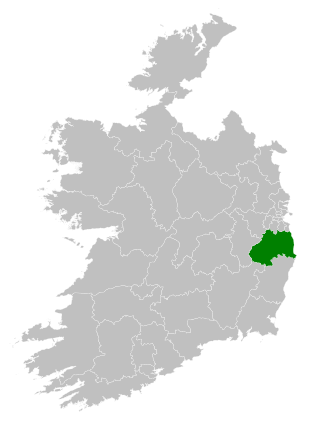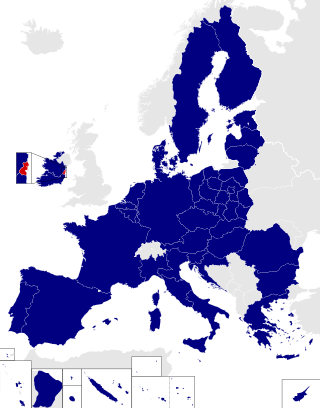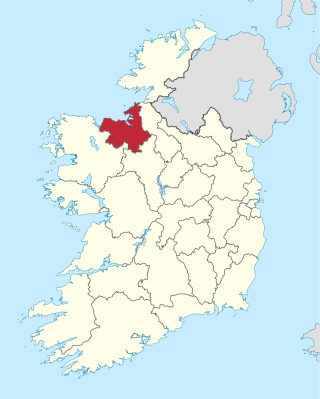In Ireland, direct elections by universal suffrage are used for the President, the ceremonial head of state; for Dáil Éireann, the house of representatives of the Oireachtas or parliament; for the European Parliament; and for local government. All elections use proportional representation by means of the single transferable vote (PR-STV) in constituencies returning three or more members, except that the presidential election and by-elections use the single-winner analogue of STV, elsewhere called instant-runoff voting or the alternative vote. Members of Seanad Éireann, the second house of the Oireachtas, are partly nominated, partly indirectly elected, and partly elected by graduates of particular universities.

Wexford is a parliamentary constituency represented in Dáil Éireann, the lower house of the Irish parliament or Oireachtas. The constituency elects 5 deputies on the electoral system of proportional representation by means of the single transferable vote (PR-STV).

Wicklow is a parliamentary constituency represented in Dáil Éireann, the lower house of the Irish parliament or Oireachtas. The constituency elects 5 deputies on the electoral system of proportional representation by means of the single transferable vote (PR-STV).

Dublin is a European Parliament constituency in Ireland. It elects 4 Members of the European Parliament (MEPs) using proportional representation by means of the single transferable vote.

Wicklow County Council is the local authority of County Wicklow, Ireland. As a county council, it is governed by the Local Government Act 2001. The council is responsible for housing and community, roads and transportation, urban planning and development, amenity and culture, and environment. The council has 32 elected members. Elections are held every five years and are by single transferable vote. The head of the council has the title of Cathaoirleach (chairperson). The county administration is headed by chief executive, Brian Gleeson. The county town is Wicklow.
The 1985 Irish local elections were held in all the local government areas on Thursday, 20 June 1985.

An election to Donegal County Council took place on 5 June 2004 as part of that year's Irish local elections. 29 councillors were elected from six electoral divisions by PR-STV voting for a five-year term of office.

An election to Offaly County Council took place on 10 June 1999 as part of that year's Irish local elections. 21 councillors were elected from five local electoral areas for a five-year term of office on the system of proportional representation by means of the single transferable vote (PR-STV).

An election to Offaly County Council took place on 11 June 2004 as part of that year's Irish local elections. 21 councillors were elected from five local electoral areas (LEAs) for a five-year term of office on the electoral system of proportional representation by means of the single transferable vote (PR-STV).

An election to all 32 seats on Wicklow County Council took place on 24 May 2019 as part of the 2019 Irish local elections. County Wicklow was divided into 6 local electoral areas (LEAs) to elect councillors for a five-year term of office on the electoral system of proportional representation by means of the single transferable vote (PR-STV).

An election to all 37 seats on Donegal County Council took place on 24 May 2019 as part of the 2019 Irish local elections. County Donegal was divided into 7 local electoral areas (LEAs) to elect councillors for a five-year term of office on the electoral system of proportional representation by means of the single transferable vote (PR-STV).

An election to all 40 seats on Kildare County Council was held on 24 May 2019 as part of the 2019 Irish local elections. County Kildare was divided into 8 local electoral areas (LEAs) to elect councillors for a five-year term of office on the electoral system of proportional representation by means of the single transferable vote (PR-STV).

An election to all 18 seats on Longford County Council was held on 24 May 2019 as part of the 2019 Irish local elections. County Longford was divided into 3 local electoral areas (LEAs) to elect councillors for a five-year term of office on the electoral system of proportional representation by means of the single transferable vote (PR-STV).

An election to Wicklow County Council took place on 20 June 1985 as part of the Irish local elections. 24 councillors were elected from five local electoral areas (LEAs) for a five-year term of office on the electoral system of proportional representation by means of the single transferable vote (PR-STV). This term was extended for a further year, to 1991.

An election to Sligo County Council took place on 7 June 1979 as part of that year's Irish local elections. 24 councillors were elected from four local electoral areas (LEAs) for a six-year term of office on the electoral system of proportional representation by means of the single transferable vote (PR-STV).

An election to all 28 seats on Donegal County Council took place on 7 June 1979 as part of the 1979 Irish local elections. County Donegal was divided into five county local electoral areas to elect councillors for a five-year term of office on the electoral system of proportional representation by means of the single transferable vote (PR-STV). This term was extended for a further year, to 1985.

An election to all 28 seats on Donegal County Council took place on 18 June 1974 as part of the Irish local elections. Councillors were elected from five local electoral areas for a five-year term of office on the electoral system of proportional representation by means of the single transferable vote (PR-STV).
An election to all 45 seats on the council of Dublin Corporation took place on 7 June 1979 as part of the 1979 Irish local elections. Dublin was divided into 11 borough electoral areas (BEAs) to elect councillors for a five-year term of office on the electoral system of proportional representation by means of the single transferable vote (PR-STV). The term was extended to 1985.

An election to all 28 seats on Donegal County Council took place on 28 June 1967 as part of the Irish local elections. Councillors were elected from five local electoral areas for a five-year term of office on the electoral system of proportional representation by means of the single transferable vote (PR-STV).

An election to all 28 seats on Donegal County Council took place on 30 June 1960 as part of the Irish local elections. Councillors were elected from five local electoral areas for a five-year term of office on the electoral system of proportional representation by means of the single transferable vote (PR-STV).












